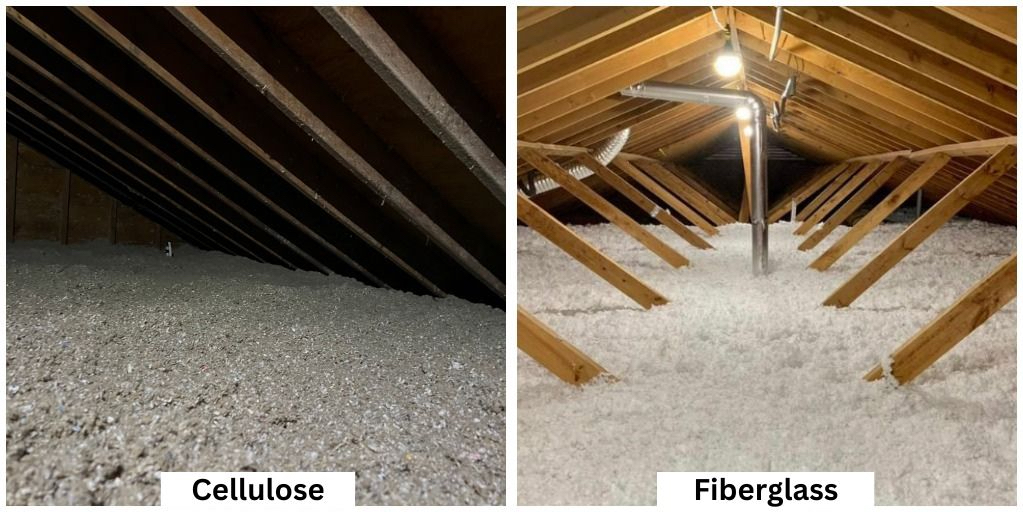Is Loose-Fill Fiberglass Better Than Cellulose?

Before diving into which loose-fill insulation is better, you first must understand how insulation and building codes have evolved over time. Over the past few decades, stricter building codes and regulations have caused building contractors and savvy homeowners to re-evaluate the different types of insulation and their overall benefits before insulating attics, walls, or crawl spaces. Over time tighter restrictions have been put in place due to insulation material ineffectiveness, or insulation materials being found unsafe for consumer use. Materials such as vermiculite or asbestos have been deemed hazardous and are no longer allowed to be used. More recently, insulation such as Cellulose, made from recycled paper products has become popular because it is environmentally friendly and because of its resistance to both fires and insects. You also must weigh the effectiveness, longevity, and safety of both Fiberglass and Cellulose to truly compare which one is better for your insulation needs.
More people are familiar with Fiberglass (the pink stuff) and while it might seem to be more cost effective, Cellulose does offer more depth in R-Value. And because it heavier than Fiberglass (think cotton candy), Cellulose is a better insulation for dense packing in existing interior and exterior walls, making it more effective than Fiberglass. Insulation in general, lasts about 20-30 years on average. Whether it’s blown-in Fiberglass or Cellulose the difference in longevity depends on how much the insulation settles which also affects how it holds its shape and form over time. Here are comparisons with pros and cons for both Fiberglass and Cellulose insulation.
FIBERGLASS INSULATION
Fiberglass insulation is made from molten glass that is spun or blown into fibers. The glass content in Fiberglass insulation can be 40% to 60% depending on the manufacturer. The loose-fill version of Fiberglass is more commonly used in attics while the Batt version can be found mainly in walls. You must exhibit caution when installing this material, as it’s a common lung and skin irritant. You should always wear long pants, a long-sleeve shirts, a face mask, gloves, and protective eyewear.
PROS
- Cost effective compared to other types of insulation
- Can be blown in or installed in sheets (Batts)
- Can last 30 years
- Made of glass fibers and other recycled material
CONS
- Not as effective at heat retention as other materials
- May cause lung, skin or eyes irritation during installation
- Not always easy to get which could impact price point
CELLULOSE INSULATION
Cellulose insulation is made from recycled paper products such as newspaper, magazines and cardboard. It’s also coated with Borate, a plant-based rodent, pest and insect repellant. This combination creates a more environmentally friendly product. It’s also safer and healthier for your family.
Because Cellulose attic insulation features recycled paper products, some homeowners may be wary of this material, as they fear it’ll present a fire hazard down the line. If you decide to invest in this type of insulation, make sure to look for a manufacturer that adds borate or ammonium sulfate. These compounds make the material resistant to both fires, insects, and rodents meaning you can create a safer and healthier living space for your family.
Cellulose is much denser than fiberglass, so it’ll provide better heat retention in the winter and cool air retention in the summer. Because cellulose consists largely of recycled materials, many homeowners view it as an eco-friendly option.
PROS
- Environmentally friendly
- Denser than fiberglass
- Resistant to fire, insects and other pests
CONS
- The installation process can produce a lot of dust
Whether it is Fiberglass or Cellulose insulation, Koala Insulation of Central CT uses caution when installing insulation. Fiberglass is known to irritate lung and skin. Causing rashes if not professionally handled. Our installation crews always wear pants, a long-sleeve shirt under a protective suit. They also wear a face mask, gloves, and protective eyewear.
Find Your Location


Get a quote


